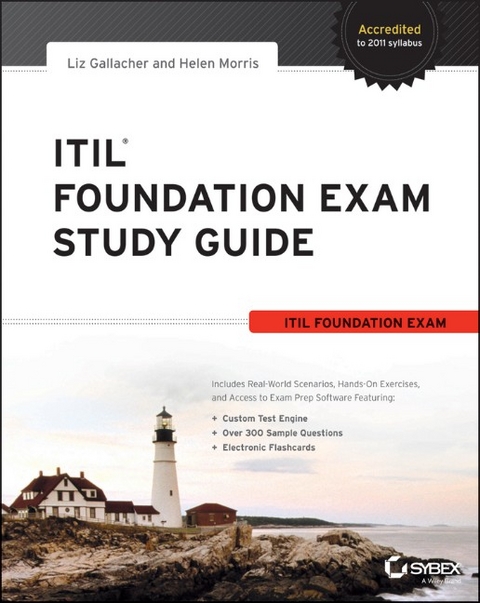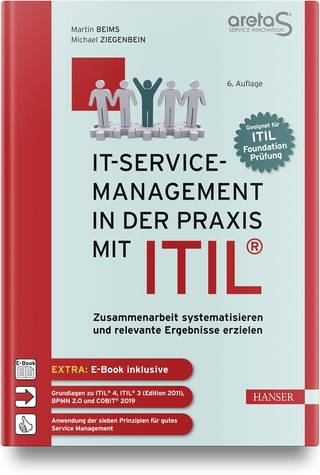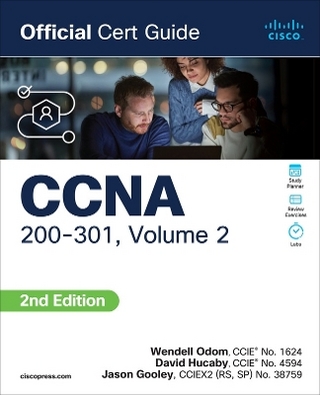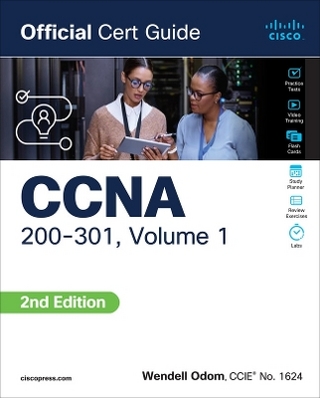
ITIL Foundation Exam Study Guide
John Wiley & Sons Inc (Verlag)
978-1-119-94275-7 (ISBN)
- Titel ist leider vergriffen;
keine Neuauflage - Artikel merken
Everything you need to prepare for the ITIL exam Accredited to 2011 syllabus The ITIL (Information Technology Infrastructure Library) exam is the ultimate certification for IT service management. This essential resource is a complete guide to preparing for the ITIL Foundation exam and includes everything you need for success. Organized around the ITIL Foundation (2011) syllabus, the study guide addresses the ITIL Service Lifecycles, the ITIL processes, roles, and functions, and also thoroughly explains how the Service Lifecycle provides effective and efficient IT services. * Offers an introduction to IT service management and ITIL V3 service strategy * Highlights the topics of service design and development and the service management processes * Reviews the building, testing, authorizing, documenting, and implementation of new and changed services into operation * Addresses creating and maintaining value for customers through monitoring and improving services, processes, and technology * Download valuable study tools including practice exams, flashcards, a glossary of key terms and more.
If you prefer self-study over the more expensive training course, but you don't want to skimp on information or preparation, then this study guide is for you.
Liz Gallacher has implemented improvement programs based on the ITIL framework for many different organizations. Liz holds the ITIL Manager and ITIL Expert certifications and was a member of the ISEB Managers Certificate Examiners panel. Helen Morris has implemented improvement programs for a wide variety of organizations, based on IT Service Management best practice. Helen holds the ITIL Manager and ITIL Expert certifications. She also holds the ISEB Consultancy certificate, and specializes in service management consultancy. Both Liz and Helen are fully accredited ITIL trainers.
Introduction xvii Assessment Test xxvii Chapter 1 Service Management as a Practice 1 Best-Practice Approaches and ITIL 2 Why Is ITIL So Successful? 4 Services, Customers, and Stakeholders 5 Identifying Types of Service 6 Understanding the Customer, Internal and External 7 Differentiating Between Internal and External Services 8 Who Are the Stakeholders in Service Management? 11 Understanding the Concepts of Service Management and IT Service Management 12 Service Management 12 IT Service Management 13 IT Service Provider Types 13 Understanding Processes and Functions 14 Processes in the Service Lifecycle 14 The Process Model 14 Process Characteristics 16 Organizing for Service Management 17 Introducing the Service Lifecycle 20 Summary 21 Exam Essentials 22 Review Questions 23 Chapter 2 Understanding Service Strategy 25 Understanding the Service Strategy Stage 26 Purpose and Objectives of Service Strategy 26 Setting the Scope for Service Strategy 27 What Value Does Service Strategy Provide to the Business? 27 Demonstrating the Value of Services 28 Understanding Key Concepts of Service Strategy 31 Utility and Warranty in Value Creation 31 Assets, Resources, and Capabilities 32 Governance and Its Place in the Lifecycle 34 Management of Risk in Service Management 34 Understanding Patterns of Business Activity 36 Summary 38 Exam Essentials 38 Review Questions 40 Chapter 3 Service Strategy Processes 43 Understanding Service Portfolio Management 44 Purpose of SPM 44 Objectives of SPM 45 Scope of SPM 45 The Service Portfolio 46 Understanding the Financial Management Process 47 Purpose of Financial Management 47 Objectives of Financial Management 48 Scope of Financial Management 48 Preparing and Using a Business Case 50 Understanding the Business Relationship Management Process 52 Purpose of the BPM Process 53 Objectives of the BPM Process 53 Scope of the BPM Process 54 Summary 57 Exam Essentials 58 Review Questions 59 Chapter 4 Understanding Service Design 61 Understanding the Purpose, Objectives, and Scope for Service Design 62 The Purpose of Service Design 63 The Objectives of Service Design 63 The Scope of Service Design 63 The Value Service Design Provides to the Business 64 Describing the Service 64 Four Key Elements of Service Design 65 People 66 Processes 66 Products 66 Partners 67 Building the Service 67 Five Major Aspects of Service Design 68 Service Solutions 69 Management Information Systems and Tools 70 Architectures 70 Measurement Systems 71 Processes 71 Summary 71 Exam Essentials 72 Review Questions 73 Chapter 5 Service Level Management: Aligning IT with Business Requirements 77 The Purpose, Objectives, and Scope of Service Level Management 78 Capturing Service Level Requirements 81 Understanding the Service Level Agreement 82 What Does an SLA Contain? 83 Building the SLA 84 Structuring the Agreement 86 Monitoring and Improving Service Delivery 88 Reviewing the Service with the Customer 90 Taking Steps to Improve: The Service Improvement Plan 91 Interfacing with Other Service Management Processes 91 Summary 92 Exam Essentials 92 Review Questions 94 Chapter 6 The Other Service Design Processes 97 Service Catalog Management 98 Understanding the Service Catalog 99 Purpose of the Service Catalog Management Process 101 Objectives of the Service Catalog Management Process 102 Scope of the Service Catalog Management Process 102 Availability Management 103 Defining Availability 103 Purpose of Availability Management 104 Objectives of Availability Management 104 Scope of Availability Management 105 Understanding the Effect of Downtime on Vital Business Functions 105 Improving Availability 106 Information Security Management 111 Purpose, Objectives, and Scope of Information Security Management 111 Producing an Information Security Policy 112 Educating Staff About Security 113 Supplier Management 114 The Purpose and Objectives of Supplier Management 115 What Is Covered by Supplier Management? 116 Supplier Categorization 116 Capacity Management 119 Delivering What Is Required, When It Is Required 120 What Should Capacity Management Include? 120 The Capacity Management Subprocesses 122 Planning for the Future: The Capacity Plan and CMIS 125 IT Service Continuity Management 126 What Does ITSCM Aim to Achieve? 127 What Is Included in ITSCM? 128 Assessing Business Impact 129 Assessing Risk 131 Design Coordination 133 Summary 135 Exam Essentials 135 Review Questions 138 Chapter 7 Service Design Roles 143 Roles and Responsibilities in Service Management 144 Service Owner 145 Process Owner 146 Process Manager 148 Process Practitioner 148 Designing Roles Using the RACI Model 149 Competence and Training 152 Competence and Skills for Service Management 152 Competence and Skills Framework 153 Specific Training in the ITIL Framework 153 Summary 155 Exam Essentials 155 Review Questions 156 Chapter 8 Understanding Service Transition and the Change Management Processes 159 Understanding Service Transition 160 The Purpose of Service Transition 160 The Objectives of Service Transition 161 The Scope of Service Transition 162 The Value of Service Transition to the Business 162 Introduction to the Change Management Process 163 The Purpose of the Change Management Process 163 Objectives of the Change Management Process 164 Scope of the Change Management Process 165 Types of Change 166 The Role of the Change Advisory Board 175 How the Change Management Process Interfaces with Other Service Management Processes 176 Summary 177 Exam Essentials 178 Review Questions 180 Chapter 9 Service Transition Processes 183 Transition Planning and Support 184 The Purpose of Transition Planning and Support 185 The Objectives of Transition Planning and Support 186 The Scope of Transition Planning and Support 187 Service Asset and Configuration Management 187 The Purpose of the SACM Process 188 The Objectives of the SACM Process 188 The Scope of the SACM Process 189 The Description and Definition of Configuration Items 190 The Description of the Configuration Model 192 Using the Configuration Management System 193 Using the Definitive Media Library 195 Knowledge Management 196 The Purpose of Knowledge Management 196 The Objectives of Knowledge Management 197 The Scope of Knowledge Management 198 Using the Data-Information-Knowledge-Wisdom Structure 198 Using the Service Knowledge Management System 200 Release and Deployment Management 201 The Purpose of the Release and Deployment Management Process 202 The Objectives of the Release and Deployment Management Process 202 The Scope of the Release and Deployment Management Process 203 Creating the Release Policy 204 Managing the Four Phases of Release and Deployment 205 Summary 206 Exam Essentials 207 Review Questions 209 Chapter 10 Delivering the Service: The Service Operation Lifecycle Stage 211 Understanding the Purpose, Objectives, and Scope of Service Operation 212 The Purpose of Service Operation 212 The Objectives of Service Operation 213 The Scope of Service Operation 213 The Value Service Operation Delivers to the Business 214 Organizing for Service Operations 215 Technical Management 215 Applications Management 216 Operations Management 219 Objectives 221 Overlapping Responsibilities Between Functions 221 The Service Desk Function 223 Summary 231 Exam Essentials 231 Review Questions 233 Chapter 11 The Major Service Operation Processes 237 Incidents and Problems: Two Key Service Management Concepts 238 Incident Management 238 The Purpose of Incident Management 239 The Objectives of Incident Management 239 The Scope of Incident Management 240 Basic Concepts for Incident Management 240 Managing Incidents 243 Interfaces Between Incident Management and the Lifecycle Stages 252 Problem Management 253 The Purpose, Objectives, and Scope of Problem Management 254 Problem Management Concepts 255 Managing Problems: The Problem Management Process 257 Interfaces 261 Service Strategy 261 Service Design 262 Service Transition 262 Continual Service Improvement 263 Summary 263 Exam Essentials 264 Review Questions 265 Chapter 12 The Other Service Operation Processes 267 Event Management 268 The Purpose of Event Management 269 The Objectives of Event Management 269 The Scope of Event Management 270 Monitoring and Event Management 271 Request Fulfillment 271 Purpose 272 Objectives 272 Scope 275 Access Management 275 Purpose 275 Objectives 276 Scope 276 Summary 277 Exam Essentials 278 Review Questions 279 Chapter 13 Understanding Continual Service Improvement 283 Achieving Continual Service Improvement 284 Understanding the Purpose of CSI 284 The Objectives of CSI 285 Setting the Scope for CSI 286 How CSI Provides Value to the Business 287 Utilizing the Continual Service Improvement Approach 287 Capturing Your Improvements 289 Improving Quality with the Deming Cycle 292 The Role of Measurement in CSI 293 The Seven-Step Improvement Process 296 Step 1: Identify the Strategy for Improvement 298 Step 2: Define What You Will Measure 299 Step 3: Gather the Data 300 Step 4: Process the Data 301 Step 5: Analyze the Information and Data 302 Step 6: Present and Use the Information 303 Step 7: Implement Improvement 303 DIKW and the Seven-Step Improvement Process 305 PDCA and the Seven-Step Improvement Process 305 Summary 306 Exam Essentials 306 Review Questions 308 Appendix A Answers to Review Questions 311 Appendix B Sample Foundation Examinations 325 Appendix C About the Additional Study Tools 357 Index 361
| Erscheint lt. Verlag | 15.10.2012 |
|---|---|
| Verlagsort | New York |
| Sprache | englisch |
| Maße | 186 x 234 mm |
| Gewicht | 754 g |
| Themenwelt | Informatik ► Weitere Themen ► Zertifizierung |
| Sozialwissenschaften ► Pädagogik | |
| Wirtschaft ► Betriebswirtschaft / Management ► Unternehmensführung / Management | |
| ISBN-10 | 1-119-94275-6 / 1119942756 |
| ISBN-13 | 978-1-119-94275-7 / 9781119942757 |
| Zustand | Neuware |
| Informationen gemäß Produktsicherheitsverordnung (GPSR) | |
| Haben Sie eine Frage zum Produkt? |
aus dem Bereich


